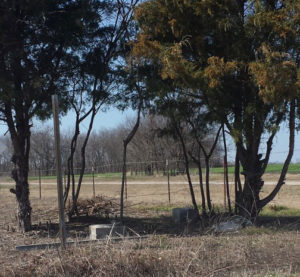
Courtesy of Kathy Hall. Mass grave of five people who died of dreadful small pox east of Muddig. Thirteen people in all were quarantined in a tenant farmer’s house, including three children, for two weeks in 1901. When the quarantine was lifted, the house and all belongs were burned to keep disease from spreading.
The Texas Historical Commission is the Preservation Agency for the State of Texas. Not only do they approve all the roadside historical markers in the state, but also they have specialists who answer questions about house histories, who suggest ways to preserve buildings, and who are authorities in archeology. There are courthouse specialists as well as cemetery specialists. On my To Do list this spring is to apply for Historic Texas Cemetery Designation for a very small burial site in the far northeast corner of Hunt County.
It is without a doubt one of the saddest stories I ever heard. A Farm Road and a County Road corner the plot. Three tombstone bases are visible and one very small piece of limestone with the letter “A” etched on one side. These items lay under three cedar trees. The ground is far from smooth and the three bases appear as if they had been tossed asunder by an upheaval under the ground.
The cemetery has no name. A woman who lives west of Fort Worth contacted me last fall. The deceased were all related to one of her grandfathers. I met her there last Sunday. We decided to first name the cemetery, using the family name. Then the woman handed me an article from an unknown source, probably a newspaper from Bonham or Honey Grove.
The article, titled “Tragedy at Lost Prairie,” does tell a tragic story. Thomas and Matilda Evans were tenant farmers on land owned by a Mr. Jackson. The Evans family was sharecropping to buy part of the land. The couple was parents to seven children, all young adults. One of the daughters and her husband along with their little girl Grace had gone to the Oklahoma panhandle to homestead their own land. In late March 1901, the young couple rode the train back to Ladonia. Family met them and the whole family looked forward to a big reunion.
Unknowingly Grace’s mother had been exposed to smallpox and became very ill shortly after arriving at the family farm. She became ill the first week of April. Hunt County medical officer Dr. Milner was notified and took charge. Mr. Bond, a neighbor who had survived smallpox, was called to help, as he then was immune. The young mother died on April 7. Her body was wrapped in a blanket and laid out in the field behind the house where it stayed until arrangements could be made. Officials in Fannin and Delta counties refused to allow the body to be transported across county lines.
Landowner Jackson gave permission to bury the body in a far corner of yard. Bond wrapped a rope around the body, mounted his horse and drug the corpse to the site. The rest of the family, all thirteen, remained quarantined in the house for two more weeks. The next victim was the young mother’s mother, followed by her father and two young nieces. All five victims were buried in a single grave.
When the rest of the family was released from quarantine, the house was burned to the ground, destroying the deadly virus. Some years later, a nephew fenced the burial ground, and purchased three obelisks, each about four feet tall. Since then, unknown persons removed the fence and markers. Today little remains to tell their story.
This is not a typical story found in Designated Texas Historic Cemeteries, but it definitely needs notice. Once we complete the paper work, we will submit the application to Austin where staff will review and hopefully approve it. At that point, the chairman of our historical commission will receive an addendum to the property deed. That will be submitted to the county clerk who attaches it to the property deed and a copy to any adjacent property deeds. This ensures that the small cemetery cannot be destroyed any more. At that point, the descendant will determine if any improvements will be made.
If you know of any unmarked graves or cemeteries exist anywhere in Hunt County, please contact me. Thank you.

Mrs. Taylor,
Has any work been done on preserving and restoring the Hopkins Cemetery? (I am referring to the one in the middle of a field, overgrown with many buried-by-time headstones.) It is of interest in that both blacks and whites are buried there and it appears that the interments of many people of both races took place in the 1860’s. This does not appear to be the norm for that time period.
Thanks for your response.